Apple iPad mini with Retina Display: Reviewed
by Anand Lal Shimpi on November 16, 2013 8:00 AM ESTThe SoC
The iPad mini with Retina Display rounds out the three platforms that use Apple’s A7 SoC. Although both the iPad Air and iPhone 5S use the A7, the mini’s implementation is closer in nature to the iPhone. The iPad mini’s SoC has always used the same package-on-package (PoP) assembly as the iPhone, with DRAM stacked on top of the SoC itself (1GB in this case). The benefit is obviously a reduction in board area, the downsides have to do with cost and thermals. That’s the first similarity between the mini’s A7 and the iPhone’s A7.
The second is one of frequencies. While the iPad Air’s A7 runs its two Cyclone CPU cores at up to 1.4GHz, the SoC in the iPad mini and the iPhone 5S runs at up to 1.3GHz. That might sound like a minor difference, but it’s far more pronounced when you look at what happens to frequency when you’re running heavy workloads.
Once again I turn to a fairly heavy CPU workload to plot performance over time. This is a multithreaded workload, slightly modified from what we used in the iPad Air review, designed to make the CPU cores consume max power. The scale is linear and the workload is the same across all devices, so what you’re effectively looking at is a graph of thermally bound CPU performance over time across all three A7 implementations:
Being the largest device (and the only device with a metal heat spreader and no DRAM stacked on top), the iPad Air obviously maintains the highest frequencies for the duration of the test. The iPhone 5S, with a significant reduction in internal volume (and a PoP SoC) reduces its CPU frequencies early on in order to keep skin temperature down and properly manage thermals. The iPad mini with Retina Display falls between the two, with its performance curve more closely following that of the iPhone 5S.
Although the mini has a similar max operating frequency to the iPhone 5S, it is a faster device thanks to it being less thermally constrained. Similarly, the iPad Air can be much faster than its clock speed would otherwise imply. If you’re wondering why Apple has been so focused on building its own SoCs and CPU architectures, this is the reason why. There’s a fixed amount of power you can dissipate in the form of heat in these mobile devices while still maintaining a good user experience. Performance per watt is the gating metric for success in mobile, and shipping high IPC/low frequency dual-core SoCs at 32/28nm is the best optimization available to a company like Apple today.
As you’d expect, our browser based CPU tests show the mini’s A7 performing in between the iPhone 5S and iPad Air. None of these tests are anywhere near as stressful as our thermal test from above, so we don’t see exaggerated differences in performance between the platforms. For most, I suspect you won’t notice a huge performance difference between the mini and Air. Those who are heavier users (e.g. audio mixing, 3D gaming, etc…), there will be a performance difference between the two iPads.
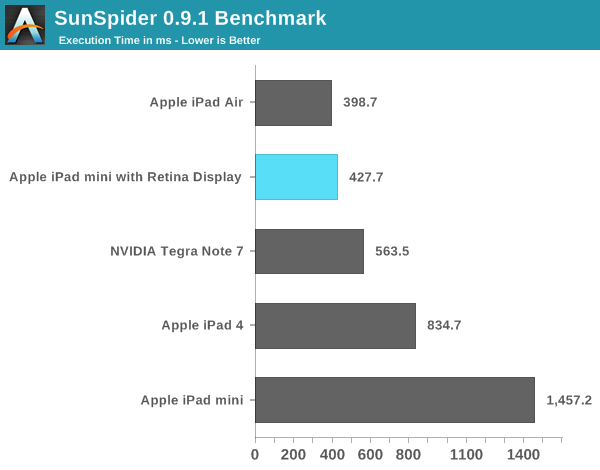

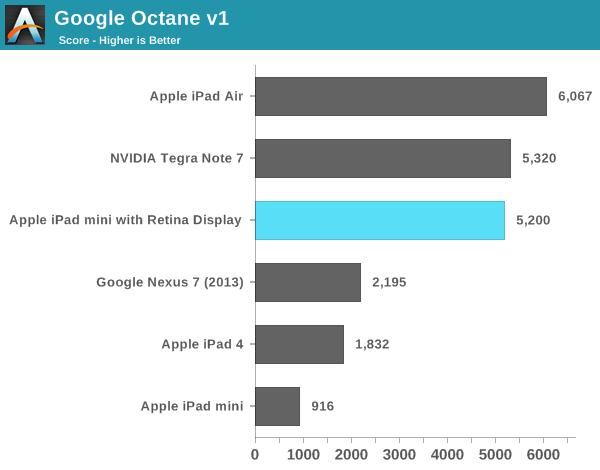
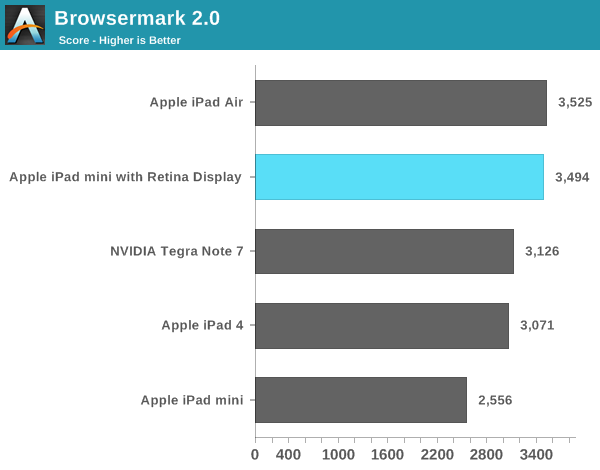
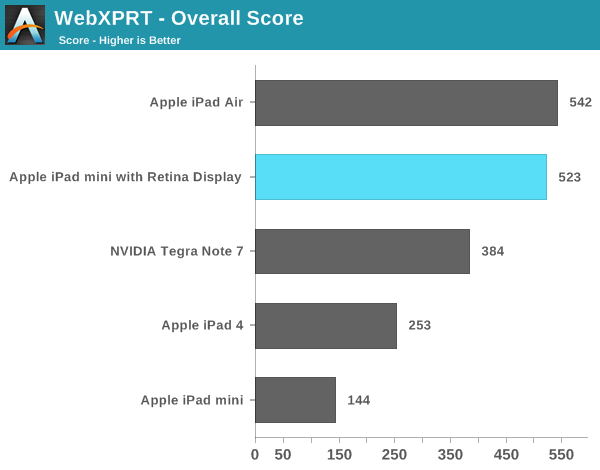
Compared to the first generation iPad mini, the new model is in a completely different performance league. Keep in mind the first mini used Apple’s A5 SoC based on an ARM Cortex A9. That’s the same single threaded performance as what’s in an iPhone 4S, and under iOS 7 it’s clearly running into some performance limits. The new mini with Retina Display however is a completely different animal. It’s fast.
Even comparing to the 4th generation iPad, the new mini is noticeably quicker.
Memory Bandwidth
Looking at the iPad mini’s memory bandwidth curve, we see it tracks very closely with that of the iPhone 5S. This is a slightly modified version of our previous bandwidth test, and you can see peak usable memory bandwidth (from the CPU’s perspective) of around 10GB/s. The ~12GB/s area right before you get out to main memory is bandwidth to the A7’s 4MB system-wide cache that sits after the shared L2 and the memory controller. This cache appears to service CPU, GPU and ISP requests at least.
GPU Performance
I believe the A7’s PowerVR G6430 GPU runs at around 450MHz. This frequency appears unchanged across all three A7 implementations. Once again, the big difference is how much thermal headroom exists in the platform which has an impact on overall performance.
Kishonti’s low level GPU performance tests back up my assertion that GPU frequency is fixed across all A7s. The iPad mini with Retina Display delivers equal performance to the iPad Air. The bigger news here is that nearly all of the GPU bound 3D tests seems to peg the mini and Air as equals. These are some pretty intense tests, but it looks like on the GPU side there’s no significant throttling when running at full tilt.
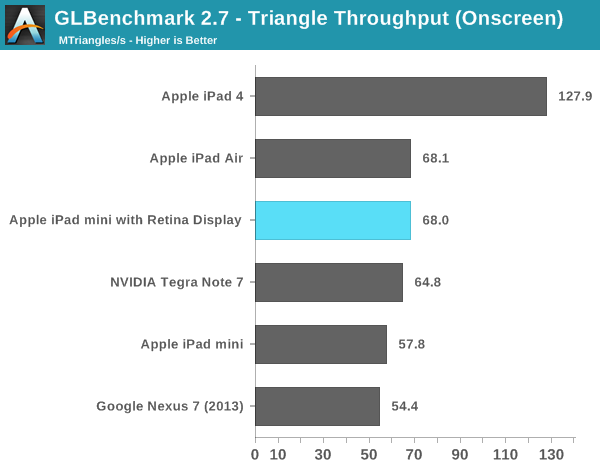

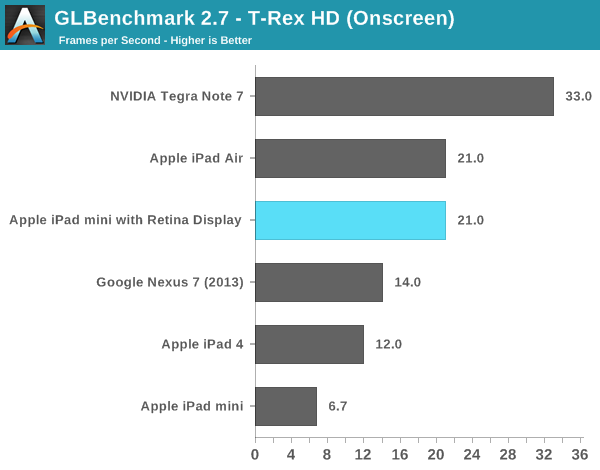

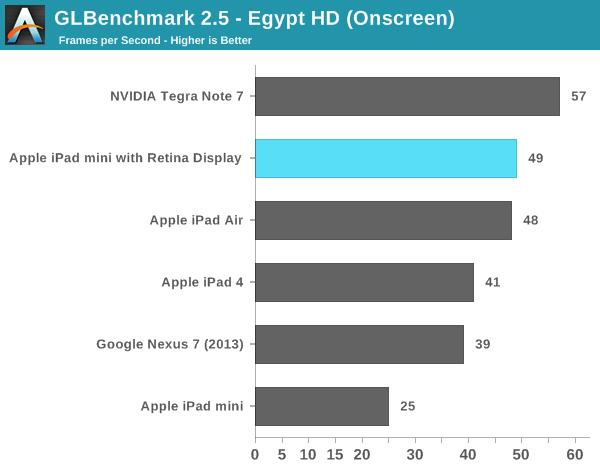
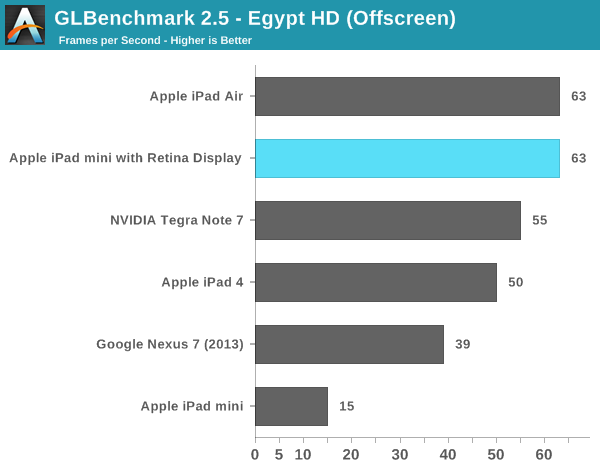
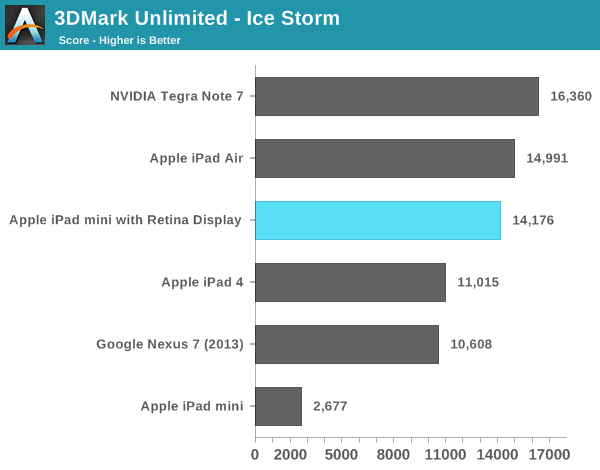
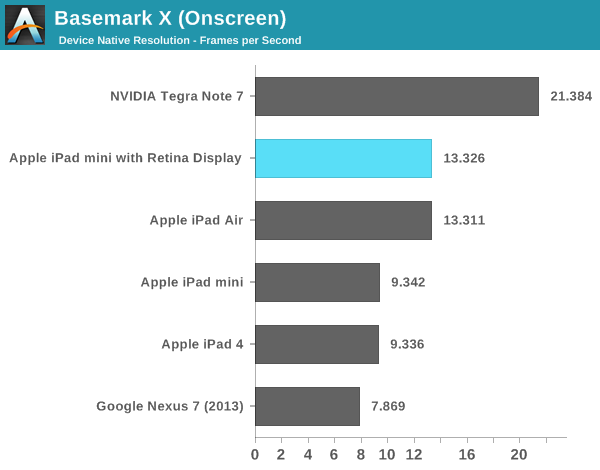
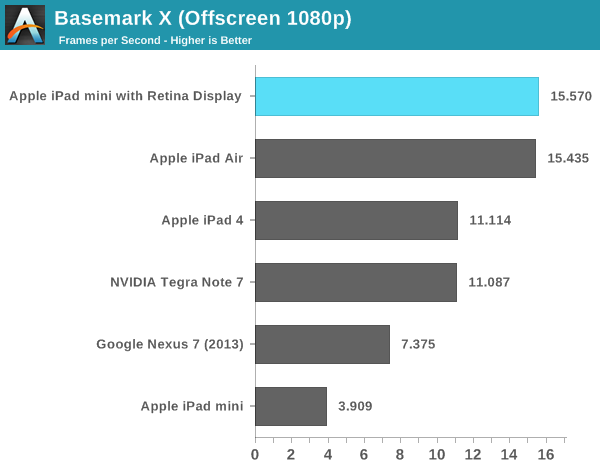
As I mentioned in our iPad Air review, despite having less peak theoretical memory bandwidth than the A5X/A6X, the A7 in the iPad mini never seems to regress in performance compared to even the iPad 4. Across the board the mini appears to be faster, more responsive and have more performance on tap than any prior iPad (big or small). The comparison to the original iPad mini is of course night and day. Even looking at lighter tests like the old GLBench Egypt HD benchmark, the iPad mini with Retina Display manages to be nearly twice as fast as the original mini - all while rendering 4x the number of pixels.


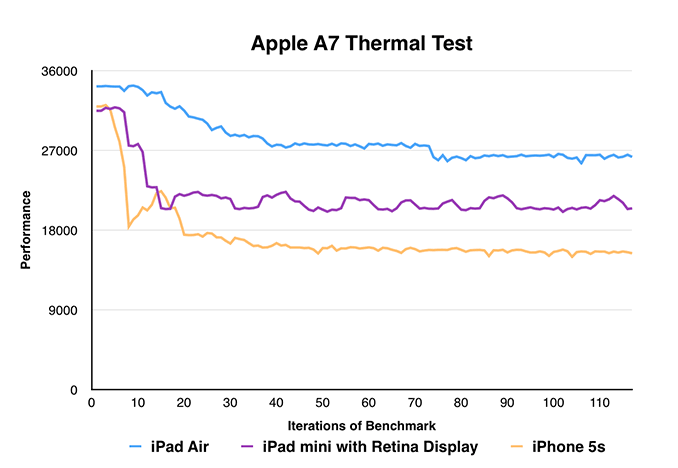
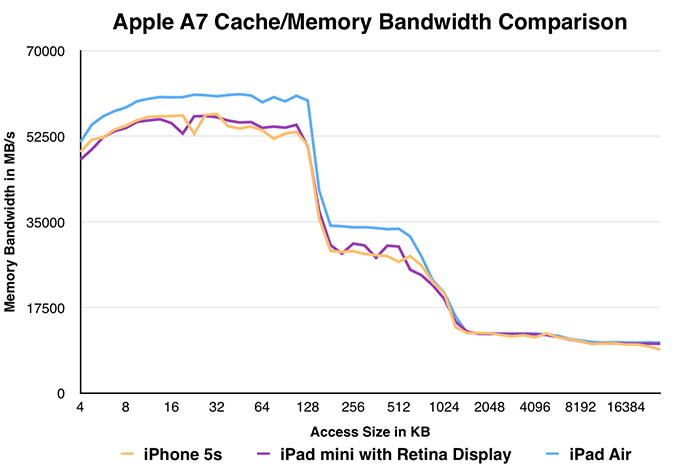








345 Comments
View All Comments
allanwood - Sunday, November 17, 2013 - link
I just checked the iPad Mini w/ Retina at the store yesterday, and it doesn't have a bonded display, just like the first mini.The easiest way to check for a space between the LCD and cover glass is to look at a reflection of a light in the screen at an angle. If you see a strong reflection and a weaker one, it has a gap. One strong reflection means it doesn't.
Spoony - Monday, November 18, 2013 - link
I am quite sure that the original Mini had optically bonded glass and panel. Multiple technical publications including this one I believe have stated that the originally Mini is that way. Additionally, my limited in-person experience with the Mini have definitely shown it to be bonded.allanwood - Monday, November 18, 2013 - link
Nope. This is from DisplayMate:"The Kindle Fire HD and and Nexus 7 both have their Cover Glass bonded directly to the LCD so there is no Air Gap like on the iPad mini, which has 3 widely separated reflections. The lack of an Air Gap helps to reduce the Reflectance for Ambient Light."
versesuvius - Saturday, November 16, 2013 - link
Apple is the company of few products and huge resources, with a brand name to boot (as in it will be bought no matter what). There are other companies with the same level or resources but they make many products. Samsung produces hundreds, perhaps thousands of individual products. Hundreds of phones. Apple produces one at a time. Nothing wrong with that, but while there is nothing that Samsung can learn from Apple, smaller companies could learn a lot from Apple. The way technology is advancing and getting cheap to the point of irrelevance, those companies could sink deadly bites into Apple, to the benefit of all around the world.KPOM - Saturday, November 16, 2013 - link
Nice review as always. Thanks for confirming our suspicions about the color gamut. I have both the Air and retina mini right now and noticed a difference. I think I'll still keep the mini and return the Air, though. The portability trounces the display difference for me.I have noticed that both the Air and the Retina Mini seem twitchy with my Sprint Aircard (Sierra Wireless 803s). It is somewhat moot for me as I bought the LTE versions, but I noticed this behavior with two different iPad Airs and the retina mini. It struggles to connect in the first place, and frequently disconnects. I did not notice this at all with the previous mini, and when I tested it with the iPhone 5s it seemed to work fine. I suspect an incompatibility somewhere as both an extended chat session and Genius Bar trip couldn't resolve the issue (we tried numerous different rested and setting changes). I haven't tried it with the wifi-only version, but I'm curious if this is a larger issue and/or something that can be resolved through firmware. I also noticed the Air had a harder time than my PC at connecting to a hotel wifi network but it eventually did (I'll experiment with the mini next week). I haven't noticed any issues connecting to Apple Airport-driven wifi networks but still need to test it with non-Apple routers.
KPOM - Saturday, November 16, 2013 - link
Are there other reasons why Apple might have chosen a lower gamut display? Does it impact battery life or is it cheaper to produce? Or is it just one more reason to try to up sell the pricier Air model?Aenean144 - Saturday, November 16, 2013 - link
Yield would be my bet.Morawka - Saturday, November 16, 2013 - link
i'm guessing nobody could make this panel but sharp, since they own IGZO tech. Then again,color could be off because the glue is still wet lol......nunomoreira10 - Saturday, November 16, 2013 - link
The gamut is generally depended on the leds used in the baclight.higher gamut leds are less eficient and more expensive then lower gamut leds, so its a trade-off between battery life and quality.
Morawka - Saturday, November 16, 2013 - link
What do you know? anand doing another apple review.